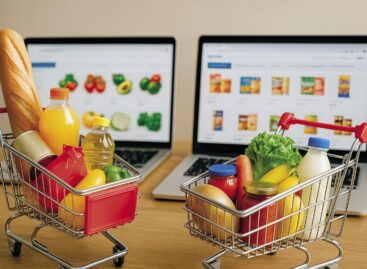Digital revolution – retail trends in 2022
Last year retailers finally understood: a strong digital presence is fundamental if they want to be successful. In 2022 they needed to go one step further, as this year special digital shopping experience is taking the centre stage. Such experience can only be offered with the help of technology service providers. It is them who are able to help retail chains in improving their existing digital solutions.
Click and Collect and smart omnichannel shopping cart
Click and Collect became popular during the pandemic, and this made it possible for many shops to sell without launching their own home delivery service. As shoppers get to like Click and Collect more and more, retailers will need integrated data analysis and order management solutions.

The Click and Collect method has spread during the pandemic
Digital and physical shopping experience can be combined in many ways. Smart shopping cart is one of these: it is basically a cloud-based shopping cart that shoppers can fill, save their favourite products and pay for its contents in any physical or digital channel.
Hyper-personalisation and mixed reality
Opinion analysis, artificial intelligence (AI) technology and machine learning already make it possible for retailers to acquire large quantities of unstructured consumer data. This mass of data can help them understand consumer needs, worries or where the customer is on the shopper route in a given moment. With the help of their findings, retailers will be able to send precisely targeted messages to shoppers.

The development of cognitive technologies facilitates retailers’ getting closer to true hyper-personalisation
Augmented reality (AR) and virtual reality (VR) are already used in retail trade. AR apps are now experimenting with a virtual “try before you buy” experience. VR practically takes shoppers to another world, where they can test products virtually.
Data-based inventory management automation and flexible payment
Data-based inventory analysis and management can tell what products and how much of them the individually targeted customers need, what is more, it can also predict how consumer taste will change with the passing of time. No wonder that smart warehouse management is one of the fastest developing and most popular trends in the sector.

Current and former inventories may exactly indicate which and how many products an individually targeted customer needs
The easier shoppers can pay, the more satisfied they are. This is why retailers are working hard on developing one flexible payment option after the other. However, consumers don’t just want flexibility in the form payment, but in payment time as well. “Buy now, pay later” options are offered by a growing number of retailers, with payment solutions such as Afterpay, Klarna or ZipPay.
Supply chain: efficiency and transparency
In 2022 one of the key factors in Delivery 2.0 is the supply chain’s efficiency and transparency. This year automatic delivery solutions are very likely to focus on the crucial last mile. As for transparency and safety, blockchain technology is transforming into a decentralised, open source code registry, which can reliably record transactions across the full product path – this can’t be changed anymore, it can only be added to or updated.

Blockchain technology is the most perfect way to make the supply chain transparent
//
Related news
The battle of digital shelves
🎧 Hallgasd a cikket: Lejátszás Szünet Folytatás Leállítás Nyelv: Auto…
Read more >Joining quality systems helps to recognize domestic products
🎧 Hallgasd a cikket: Lejátszás Szünet Folytatás Leállítás Nyelv: Auto…
Read more >Does food become more expensive because it passes through too many hands? – Tamás Éder spoke about supply chains and the illusion of “shortening”
🎧 Hallgasd a cikket: Lejátszás Szünet Folytatás Leállítás Nyelv: Auto…
Read more >Related news
The New Year’s Eve fireworks fair is back: temporary sales will start in department store parking lots at the end of December
🎧 Hallgasd a cikket: Lejátszás Szünet Folytatás Leállítás Nyelv: Auto…
Read more >The first Eastern European non-alcoholic beer turns 50
🎧 Hallgasd a cikket: Lejátszás Szünet Folytatás Leállítás Nyelv: Auto…
Read more >Sausage: pork prices are already going down, but they won’t be cheaper in stores – a significant correction may come in the spring at the earliest
🎧 Hallgasd a cikket: Lejátszás Szünet Folytatás Leállítás Nyelv: Auto…
Read more >






